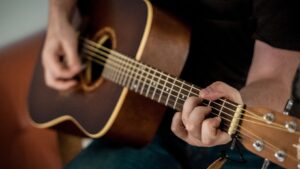 Guitar enthusiasts often seek out the chords for popular songs, and “Isabella” by ST12 is no exception. This hit track has captured the hearts of many with its melodic tune and heartfelt lyrics, making it a favorite among guitar players looking to add some emotional depth to their repertoire. The chord progression in “Isabella” offers a blend of simplicity and expressiveness, appealing to both novice and experienced musicians.
Guitar enthusiasts often seek out the chords for popular songs, and “Isabella” by ST12 is no exception. This hit track has captured the hearts of many with its melodic tune and heartfelt lyrics, making it a favorite among guitar players looking to add some emotional depth to their repertoire. The chord progression in “Isabella” offers a blend of simplicity and expressiveness, appealing to both novice and experienced musicians.
Understanding the chord gitar ST12 – Isabella requires familiarity with basic guitar chords as well as an appreciation for how music can convey emotion through melody and harmony. The song’s structure provides a fantastic opportunity for players to practice transitions between chords smoothly while also delving into more complex strumming patterns that mirror the song’s dynamics. For those aiming to master “Isabella,” focusing on accurate chord placement and timing can significantly enhance one’s performance. Moreover, integrating the emotional essence of the song into one’s playing can transform a simple cover into a powerful musical expression. Whether played around a campfire or as part of a larger setlist, mastering the chords for “Isabella” by ST12 not only expands a guitarist’s musical library but also connects them more deeply with their audience through this beloved track.
Chord Gitar ST12 – Isabella
 Crafting the intro to a song is like setting the stage for an unforgettable performance. For “Isabella” by ST12, the chord progression sets a mood that immediately captures the listener’s attention. It begins with a soft yet impactful combination of chords that lay the foundation for the melody and lyrics to build upon. Guitar enthusiasts often seek out the chord gitar ST12 – Isabella for its unique blend of harmony and emotion. The intro typically involves a sequence that might seem simple at first glance but requires precision and feeling to execute perfectly.
Crafting the intro to a song is like setting the stage for an unforgettable performance. For “Isabella” by ST12, the chord progression sets a mood that immediately captures the listener’s attention. It begins with a soft yet impactful combination of chords that lay the foundation for the melody and lyrics to build upon. Guitar enthusiasts often seek out the chord gitar ST12 – Isabella for its unique blend of harmony and emotion. The intro typically involves a sequence that might seem simple at first glance but requires precision and feeling to execute perfectly.
The introductory chords serve as an invitation into the song’s deeper narrative, creating anticipation for what’s next. They’re not just notes strung together; they tell a story all on their own, setting up listeners for the journey ahead. This makes mastering them not only essential for covering “Isabella” accurately but also for conveying its essence right from the start.
Verse

Chorus

For those looking into chord gitar ST12 – Isabella specifics, mastering this segment opens up avenues for creative expression within well-defined musical boundaries. It’s about striking balance—between adhering faithfully to original compositions and infusing personal flair into performances. The chorus reinforces themes introduced earlier while elevating them through intensified musicality. Achieving this heightened level of engagement requires practice but ultimately rewards players with richer understanding and appreciation of both music theory and storytelling through sound.
Tutorial for Playing “Isabella” on Guitar
Finger Placement

- E Major: Position your index finger on the G string (3rd string) at the first fret, your middle finger on the A string (5th string) at the second fret, and your ring finger on the D string (4th string) also at the second fret.
- A Minor: Place your index finger on B string (2nd string) at first fret, your middle finger on D string (4th string) at second fret, and ring finger on G string (3rd string) at second fret.
Practicing these chords until they can be played cleanly is vital. Use a mirror or video yourself to check that each fingertip presses firmly down just behind the appropriate frets without touching other strings unintentionally.
Strumming Pattern

- Downstroke across all relevant strings
- Missed upstroke (the hand moves up without strumming)
- Upstroke
- Pause
Rhythmically, it’s about creating a balance between smoothness and accentuating certain beats to match the song’s emotional intensity.
Tips for Smooth Transitions

- Visualize Before Moving: Before switching chords, visualize where each finger needs to go next.
- Practice Slow Transitions: Initially focus on accuracy over speed; muscle memory will naturally increase speed over time.
- Use Minimal Finger Movement: Keep fingers close to the fretboard when moving them from one chord position to another.
Incorporating these practices into daily practice sessions will not only improve transitions in “Isabella” but also enhance overall playing proficiency.
Playing “Isabella” by ST12 involves careful attention to detail in terms of both technique and emotional expression through guitar play. By focusing diligently on correct fingering placements, mastering an expressive strumming pattern, and implementing strategies for smoother chord transitions, guitarists of all levels can enjoy bringing this beloved song to life.
Common Mistakes to Avoid
Incorrect Chord Voicings

- Open chords provide a fuller, resonant sound perfect for acoustic renditions.
- Barre chords allow for easier transitions but may sound too harsh if not played correctly.
Striking the right balance requires practice and an ear tuned to the nuances of each version. Players should also pay attention to hand positioning and fingering techniques as incorrect methods can lead to muted strings or unintended dissonance.
Timing Issues
Timing is another critical aspect where many falter while playing chord gitar ST12 – Isabella. The tempo and rhythm of this song are pivotal in conveying its emotional depth. Unfortunately, getting carried away with strumming patterns or rushing through chord transitions is all too common among beginners and even some intermediate players.
Key points include:
- Practicing with a metronome helps maintain consistent timing.
- Listening closely to the original track aids in understanding the rhythmic flow.

In summary, avoiding these mistakes involves a mix of technical skill, auditory sensitivity, and dedicated practice. Whether it’s mastering chord voicings or nailing down timing, each step taken towards improvement enriches your rendition of chord gitar ST12 – Isabella, making it all the more rewarding both for you and your audience.














